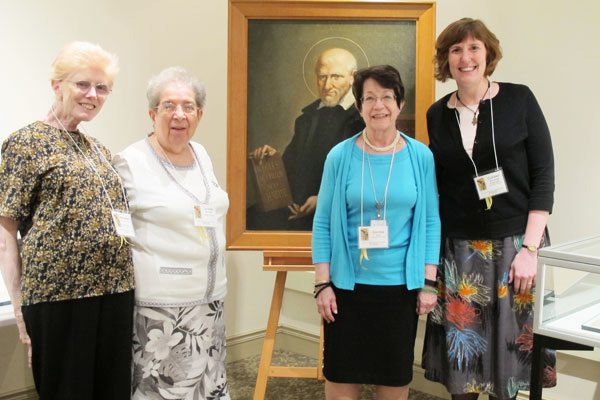“Going down into the archives, you never know what you’re going to find.”
Dee Gallo, Provincial Archivist for the Daughters of Charity, Province of St. Louise, has been working in the archives of the Emmitsburg, Maryland campus for five years, retrieving old photographs, letters and historical documents that relate to the beginnings of St. Elizabeth Ann Seton’s Sisters of Charity of St. Joseph’s and the history of the Daughters in America. Recently, however, Dee became aware of how some of the materials in her archives actually relate to Federation history.
When Dee learned in 2012 that the Federation and the Seton Shrine would eventually be connected, she decided to try to gather other Sisters of Charity archivists for a meeting to determine how they might work together in the future. Thus began a broad collaboration that has led to joint exhibits, a formal Charity Federation Archivists group, and the discovery of unexpected links between their archival holdings.
“Archivists have traditionally been very independent professionals,” said Colleen Rademaker, archivist for the Sisters of Charity of Leavenworth and newest member of the Federation Archivists group. “For a long time in the profession, the thinking was that we had unique collections and therefore couldn’t possibly work together. Now we are asking ourselves, ‘What do we have in common?’ ‘What can we work on together?’”
Each archivist spends time in two main areas. One area of interest is reference and outreach, presenting the archives to the world outside the congregation. This is where they spend time putting together rotating exhibits, writing posts and conducting research for genealogists, researchers and the media about particular topics of interest. The other area of interest is processing, which is the management of the archival collection through the preservation and cataloging of items.
Most recently the Federation Archivists worked on creating an exhibit for the Annual Leadership Meeting in Emmitsburg in June. Its purpose was to highlight unknown connections among the 13 Federation archives.
“This was one of the most exciting exhibits I’ve ever put together,” Dee said. “This one was a jaw dropper. I knew that anybody that saw it would be excited by it – and I think the sisters were very pleased to see the connections.”

The Federation Archivists worked for months to amass historical letters and documents that would show links between congregations, long before the congregations were formally linked together through Federation membership. Among many examples, the archivists were able to highlight a link between the Sisters of Charity of New York and the Sisters of Charity-Halifax by following document references to Halifax’s first Mother, Basilia McCann.
“We were surprised by how much the SCNY congregation had about the Canadian congregations. I found some documents that were interesting – some of the sisters in the 1840’s and 1850’s from the Canadian congregations did their novitiate in New York,” Dee said. Sister Maryellen Blumlein, archivist for the New York Charities, was able to document that in their records. “It showed that there were very deep connections already present between congregations. When you can actually see that name on the records, it makes it all very concrete and alive.”
“I thought the exhibit was marvelous, because that showed everybody that our collections are so much richer when we look at them together as a whole,” Colleen said. “It was fascinating to see the relationships right there, in black and white on paper, for the archivists and for the sisters there. Even though the congregations were not working together formally at that time, there were documents that bind us together even then.”
Now the Federation Archivists are on to their next project – furthering the digital preservation of recent congregational news and photos for future generations of sisters and researchers. They have teamed up with Archive-It.org, an online archival website harvesting and preservation service that will allow the Federation archivists in the program to have joint access to digital copies of a congregation’s websites and social media channels.
“The websites are our most read publications,” Colleen said. “We could have tried to preserve them by printing them out or downloading them as digital files in our individual repositories, but by simply talking with each other and finding out that we were each interested in preserving our websites, we came together.”
Ten of the Federation communities have signed on to this joint subscription service, which provides an easy-to-use search feature to find results.
“When you get onto the Archive-It website, you can search within the Federation subscription portal and see anything that any member congregation has published about a particular topic, like human trafficking. It gives us access to more information and it’s so much more collaborative on the search end. It’s just a great way to link media collections,” Dee said.
The Federation Archivists group, a mix of lay and sister archivists, hopes to continue to collaborate in the future as they learn more about how to work together to preserve their joint history.
“We really are very connected, and this group is proof of that,” Dee said. “Archives as a profession has become very collaborative,” Dee said. “We like working together, we share well, and we can add a totally new dimension to Federation history.”
“There are things we do better when we do them together,” Colleen said. We couldn’t agree more.

